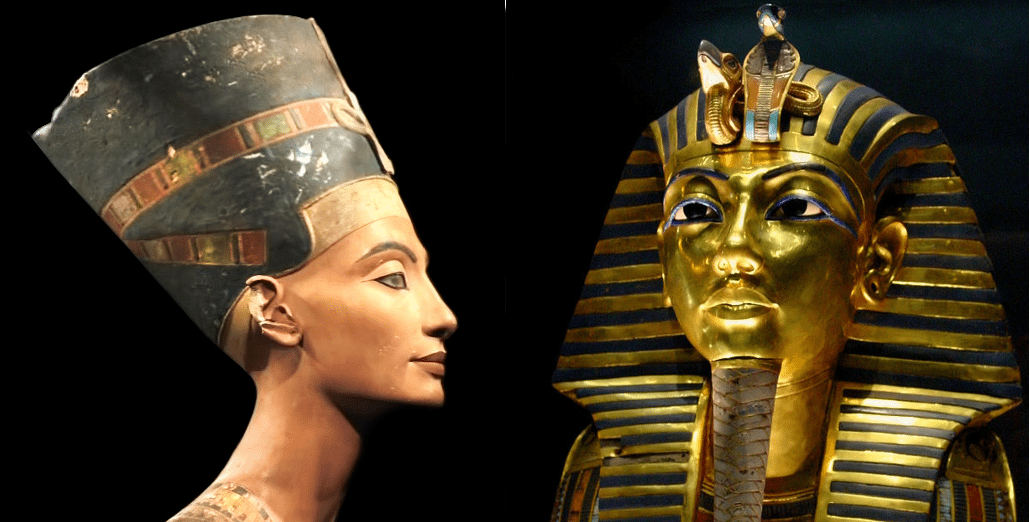
Which boy has not dreamed about discovering a pharaoh’s burial chamber, the mummy encased in a richly decorated sarcophagus and surrounded by unimaginable treasure, untouched by grave robbers? So far, the dream has only come true once, namely for Howard Carter when he found Tutankhamun’s tomb in 1922. A recent discovery suggests that we can start dreaming again … and armchair Egyptologists young and old can follow the quest for Queen Nefertiti’s grave using fascinating source material available on the Internet.
The two most iconic depictions of old egyptian rulers certainly are the mask of King Tutankhamun and the bust of Queen Nefertiti. If the British archeologist Nicholas Reeves of the University Arizona is right, Tutankhamun and Nefertiti actually have been buried right next to each other. But when Carter discovered Tutankhamun’s tomb, he may have failed to recognize that he was just inches away from an even greater discovery: the tomb of Nefertiti, hidden behind a beautifully decorated wall in Tutankhamun’s burial chamber. If Reeves is right, that is.
Ironically, the starting point of Reeves’ possible discovery of some of the most ancient treasures of humankind, was humankind’s most modern treasure: large amounts of data. In this case, data made available to the public on the Internet by Factum Arte, a company specializing in the production of facsimiles. when they published high-resolution scans of the walls of Tutankhamun’s burial chamber in 2014. Reeves examined these images and found indications for two walled-up doorways in the burial chamber.
In his report, Reeves explains, why Carter is likely to have dismissed the possibility that further rooms might be hidden in the tomb. The walls in question feature several “amulet emplacements”, basically holes that have been cut into the wall in which amulets had been placed. These holes expose the natural limestone of the Kings’ Valley where the grave is located. Hence the conclusion that there is nothing but limestone behind those walls – and who would destroy incomparable frescos just in order to satisfy an unfounded curiosity? But maybe the placement of the amulet emplacements was made deliberately at exactly such places where the limestone had remained untouched?
The report also argues why, if there is a hidden grave beyond the southern wall of Tutankhamun’s burial chamber, it is likely that the grave is Queen Nefertiti’s final resting place. One piece of evidence lies in the frescos of the northern wall. According to the hieroglyphs, an image there shows Tutankhamun, but a closer look at the image itself reveals characteristic traits of Nefertiti’s face.
Many more pieces of evidence are given and a compelling case for the existence of Nefertiti’s burial chamber right behind the southern wall of Tutankhamun’s burial chamber is made. All in all, the report makes for fascinating reading – an archeological detective story. What is more: armchair archeologists (including, I would imagine, many a GeekDad and his children) can dive into the world of ancient treasure simply by going online.
- View the high-resolution scans of the walls of Tutankhamun’s burial chamber that got everything started: do you think there really might be walled-up doorways?
- Reeves’ report mentions that the amulet emplacements have Carter Numbers 257-260 (Carter gave a number to each artefact that was found). Want to see for yourself what the amulets looked like when Carter found them? Use the Griffith Institute’s online archive of material from Carter’s excavation to view original photos of amulets in the emplacements: simply enter a carter number in to the search form for photos from the excavation. You can also find scans of Carter’s diaries, the object card that was created for each artefact found in the tomb, maps and plans drawn by Carter and his colleagues, etc.
- Want to get an overview of all the tombs that have been discovered in the Kings’ Valley and see a map of Tutankhamun’s tomb? Hop over to the Theban Mapping Project for a wealth of information about the Kings’ Valley.
Until archeologists follow up the leads provided by Reeves and investigate the space beyond the southern wall in Tutankhamun’s burial chamber, we cannot know whether the location of Queen Nefertiti’s tomb has indeed been found. But isn’t this state of suspense the most delicious stage of a discovery anyways? Thanks to the Internet, GeekDads and their kids can participate in the excitement of the search for the second and, in all likelihood, last unmolested burial site of an ancient egyptian ruler.


